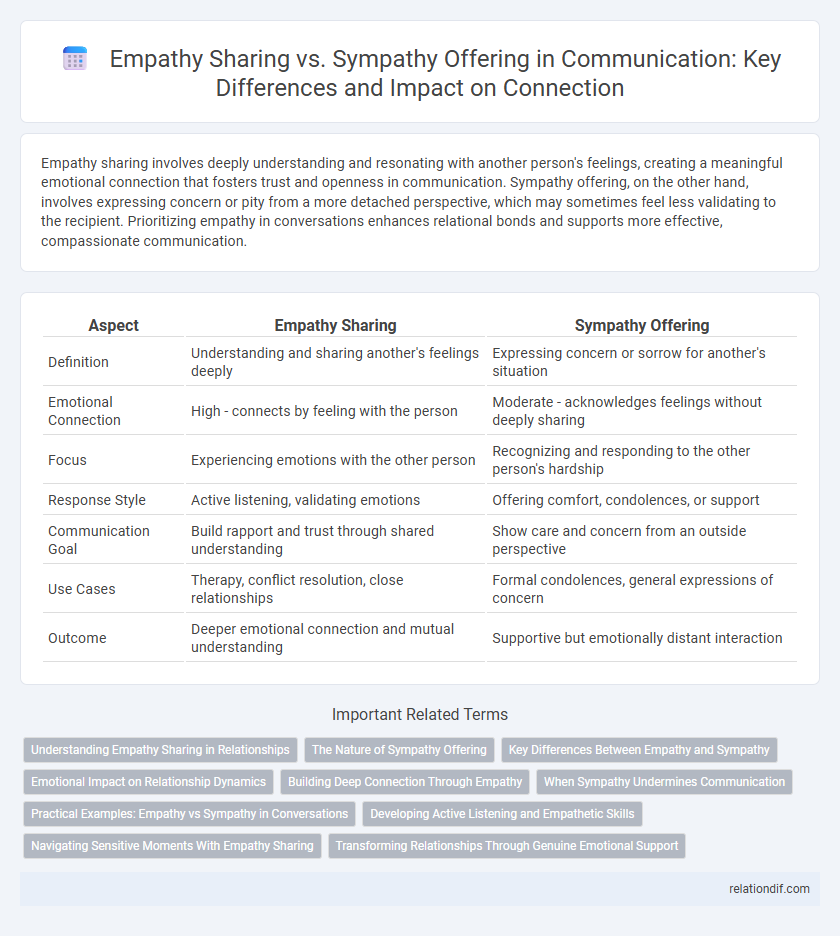Empathy sharing involves deeply understanding and resonating with another person's feelings, creating a meaningful emotional connection that fosters trust and openness in communication. Sympathy offering, on the other hand, involves expressing concern or pity from a more detached perspective, which may sometimes feel less validating to the recipient. Prioritizing empathy in conversations enhances relational bonds and supports more effective, compassionate communication.
Table of Comparison
| Aspect | Empathy Sharing | Sympathy Offering |
|---|---|---|
| Definition | Understanding and sharing another's feelings deeply | Expressing concern or sorrow for another's situation |
| Emotional Connection | High - connects by feeling with the person | Moderate - acknowledges feelings without deeply sharing |
| Focus | Experiencing emotions with the other person | Recognizing and responding to the other person's hardship |
| Response Style | Active listening, validating emotions | Offering comfort, condolences, or support |
| Communication Goal | Build rapport and trust through shared understanding | Show care and concern from an outside perspective |
| Use Cases | Therapy, conflict resolution, close relationships | Formal condolences, general expressions of concern |
| Outcome | Deeper emotional connection and mutual understanding | Supportive but emotionally distant interaction |
Understanding Empathy Sharing in Relationships
Empathy sharing in relationships involves deeply understanding and feeling another person's emotions, fostering genuine connection and trust. This approach promotes active listening and emotional resonance, enabling partners to respond with sensitivity and support based on shared experiences. Unlike sympathy offering, which positions the sympathizer as an outsider expressing pity, empathy sharing creates a mutual emotional bond that strengthens relational intimacy and communication.
The Nature of Sympathy Offering
Sympathy offering involves expressing concern or sorrow for another person's misfortune without fully understanding or sharing their emotional experience. This approach often centers on reassurance or consolation, which can unintentionally create emotional distance. The nature of sympathy offering emphasizes acknowledgment of pain rather than deep emotional connection, differentiating it from empathy sharing.
Key Differences Between Empathy and Sympathy
Empathy involves understanding and sharing another person's feelings by putting yourself in their shoes, while sympathy refers to feeling concern or pity for someone without necessarily experiencing their emotions. Empathy promotes deeper emotional connections and active listening, whereas sympathy often maintains emotional distance. Recognizing these distinctions improves interpersonal communication and fosters more genuine support.
Emotional Impact on Relationship Dynamics
Empathy sharing fosters deeper emotional connections by genuinely understanding and resonating with another person's feelings, enhancing trust and intimacy in relationships. Sympathy offering, while well-meaning, can create emotional distance by focusing on pity rather than shared experience, potentially weakening relational bonds. Prioritizing empathy in communication leads to more meaningful interactions and stronger, resilient relationship dynamics.
Building Deep Connection Through Empathy
Empathy builds deep connections by truly understanding and sharing another person's feelings, creating a foundation of trust and emotional intimacy. Unlike sympathy, which offers comfort from a distance, empathy involves active listening and validation of emotions, fostering genuine relational bonds. This emotional resonance enhances effective communication, promoting mutual respect and collaboration.
When Sympathy Undermines Communication
Sympathy can undermine communication by creating a power imbalance where the sympathizer positions themselves as superior to the person suffering. This often results in the receiver feeling misunderstood or patronized, which blocks genuine connection and mutual understanding. Empathy, in contrast, fosters open dialogue by validating emotions without judgment, promoting trust and effective interpersonal communication.
Practical Examples: Empathy vs Sympathy in Conversations
In conversations, empathy involves actively listening and reflecting the speaker's feelings, such as saying, "I can see how that situation upset you," which fosters connection and understanding. Sympathy, on the other hand, offers comfort from a distance, often using phrases like, "I'm sorry you're going through this," which can sometimes create emotional distance. Practical application shows empathy encourages deeper dialogue and emotional support, while sympathy provides immediate consolation without fully engaging in the other person's experience.
Developing Active Listening and Empathetic Skills
Developing active listening and empathetic skills enhances communication by fostering true empathy, where individuals genuinely understand and share others' feelings rather than merely offering sympathy, which can sometimes create distance. Techniques such as reflective listening, open-ended questioning, and mindful body language are critical for deepening empathetic connections. Cultivating these skills improves interpersonal relationships, promotes trust, and encourages effective emotional support in both personal and professional settings.
Navigating Sensitive Moments With Empathy Sharing
Empathy sharing involves deeply understanding and resonating with someone's emotions, fostering genuine connection during sensitive moments. This approach encourages active listening and validating feelings without imposing one's own perspective, creating a safe space for open communication. By prioritizing empathy sharing over sympathy offering, communicators build trust and support emotional healing effectively.
Transforming Relationships Through Genuine Emotional Support
Empathy sharing deepens connections by authentically understanding and reflecting others' emotions, fostering trust and mutual respect in relationships. Sympathy offering, while well-intentioned, often maintains emotional distance by focusing on pity rather than shared experience. Transforming relationships requires prioritizing empathy to create a supportive environment where individuals feel truly heard and valued.
Empathy sharing vs Sympathy offering Infographic

 relationdif.com
relationdif.com